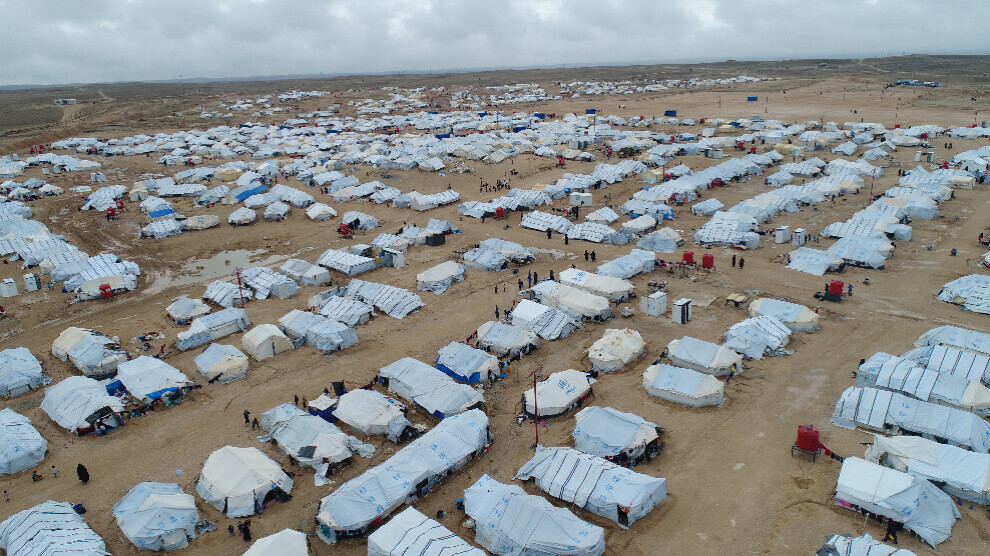The camps in North and East Syria
30,885 families are sheltering in 17 camps in North and East Syria. The needs of 145,239 people living in camps increase even more due to the harsh climatic conditions during the winter months.
30,885 families are sheltering in 17 camps in North and East Syria. The needs of 145,239 people living in camps increase even more due to the harsh climatic conditions during the winter months.

The Democratic Autonomous Administration of North and East Syria (AANES) is trying to provide food, shelter, health and education services to the people living in the camps in the region. Humanitarian aid institutions and organisations do not provide sufficient support to the camps in the region, causing refugees to experience even more difficulties.
Due to the invasion attacks launched by the Turkish state against Afrin in 2018, more than 400 thousand residents were forced to leave their city and settled in neighbouring regions. The IDPs who settled in Shehba and the districts of Afrin are still exposed to the attacks of the Turkish state. On 9 October 2019, the Turkish state launched a new invasion attack against North and East Syria. Due to the attacks, approximately 500 thousand civilians from Serêkaniyê, Girê Spî, Til Temir and Zirgan were forced to flee their homes. There are 17 large refugee camps in North and East Syria, in addition to dozens of small camps.
CAMPS IN CIZÎRÊ
Most refugees and migrants are housed in Cizîrê. There are 6 camps in the region, including two camps where ISIS families stay.
* Hol (al-Hawl) Camp: The Camp, 45 kilometres east of Hesekê, was established by the United Nations High Commissioner for Refugees (UNHCR) in 1991. The camp, which was used to shelter Iraqi refugees fleeing the Gulf War, was used once again after the US intervention in Iraq in 2003. With the beginning of the Syrian crisis, the ISIS gang occupied the camp and started to use it as a centre. The camp was liberated by the SDF (Syrian Democratic Forces) in October 2015 and has been under the control of the Autonomous Administration since. Hol is known as the most dangerous camp in the region as it also hosts the families of ISIS members. There are 45,402 people (12,700 families) in the camp, which is larger than the district of Hol.
* Roj Camp: The camp in the city of Dêrîk was established on 24 June 2015 for ISIS families. There are mostly Iraqis and Syrians in the camp, mostly from European countries. The camp is home to 2,605 people (820 families).
* Waşokanî Camp: The camp in Hesekê was established by the Democratic Autonomous Administration of North and East Syria for the people of Serêkaniyê who were forced to flee their homes after the Turkish occupation of their city in October 2019. Migrants from Serêkaniyê, Til Temir and Zirgan live in the camp. The camp consisting of three sections is home to 16,730 people (2,361 families).
* Serêkaniyê Camp: The camp, east of Hesekê, was established by the Democratic Autonomous Administration of North and East Syria in August 2020 for Serêkaniyê people who settled in schools in Hesekê due to Turkish invasion attacks. The camp accommodates 15,583 people (2,576 families).
* Newroz Camp: The camp in the city of Dêrîk was established in 2014 for the residents of Shengal (Sinjar) who fled the ISIS massacre. After many Shengalis returned to their land, people from Serêkaniyê and Girê Spî were settled in the camp, which currently houses 5,366 people (1,20 families).
* Erîşa Camp: The old camp is also home to migrants fleeing from the areas under the control of the Syrian regime, mostly from Deir ez-Zor. The camp accommodates 12,984 people (2,682 families).
TABQA
* Al-Mehmudlî Camp: The camp was established for refugees fleeing from Aleppo, Hama, Homs and Deir ez-Zor regions under the control of the Syrian regime. The camp accommodates 9,099 people (1,780 families).
* Al-Tiwêhna: The camp shelters 4,350 people (870 families).
MANBIJ
* Former Eastern Manbij Camp: The camp accommodates refugees from regime-held areas in the east of Aleppo. There are 2,170 people (408 families) living in the camp.
* New Eastern Manbij Camp: The camp accommodates refugees from Aleppo and its surroundings. The camp accommodates 4,755 people (710 families).
RAQQA
* Girê Spî Camp (Til Semin Camp): The camp was established for those from Girê Spî and its villages who left their lands due to the invasion attacks of the Turkish state in November 2019. The camp accommodates 6,886 people (1,282 families).
DEIR EZ-ZOR
* Ebû Xeşeb Camp: The camp is home to 10,510 people (1,918 families) from Deir ez-Zor who fled from Syrian-controlled areas.
CAMPS IN SHEHBA
With the Turkish occupation of Afrin in 2018, more than 400 thousand civilians were forced to leave their homes and migrate. The 5 camps (Efrîn, Veger, Serdem, Berxwedan and Şehba Camps) in Shehba and Sherawa district of Afrin accommodate those who had to migrate due to the Turkish occupation.
* Veger Camp: Home to 515 people (103 families).
* Shehba Camp: Home to 485 people (97 families).
* Serdem Camp: Home to 3,760 people (752 families).
* Berxwedan Camp: Home to 3,425 people (685 families).
* Efrîn Camp: Home to 605 people (121 families).